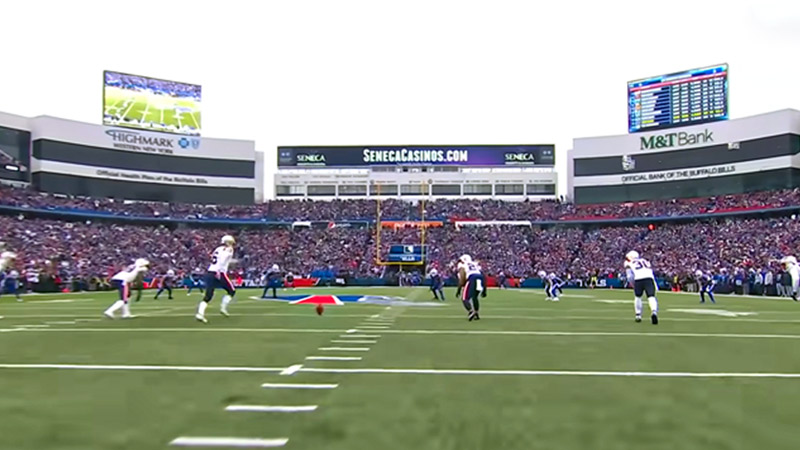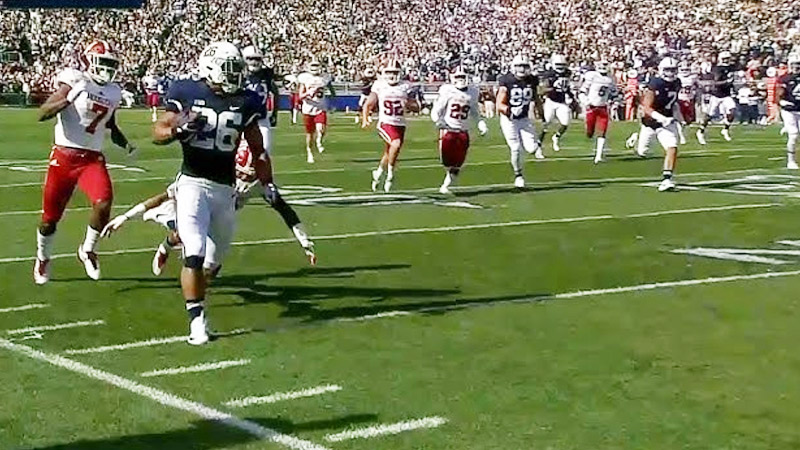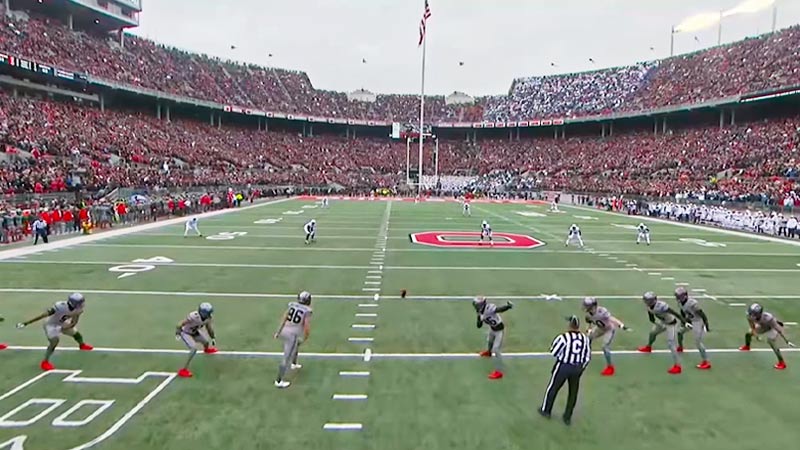The opening kickoff in American football is a moment of anticipation, marking the start of a game and setting the stage for what’s to come. But beneath the excitement lies a set of intricate rules that govern this seemingly routine play.
From the placement of the ball to the strategies employed by both the kicking and receiving teams, understanding these rules is essential for grasping the dynamics of the game.
In this guide, we’ll dive deep into the football opening kickoff rules, unraveling the complexities and shedding light on the significance of each element. So, stay focused.
What Is the Football Opening Kickoff?
The football opening kickoff in American football marks the beginning of a game, occurring at the start of each half and after scoring plays. It involves one team kicking the ball from their own 35-yard line to the opposing team.
The receiving team positions its players strategically to catch the ball and gain possession. The kickoff offers an opportunity for exciting plays, as the receiving team attempts to advance the ball up the field while the kicking team strives to prevent a significant return.
The kick returner aims to secure a good field position for their offense, while the kicking team aims to limit the return yardage. The outcome of the opening kickoff can set the tone for the game, impacting the field position and momentum of both teams.
Football Opening Kickoff Rules
The football opening kickoff in American football follows specific rules outlined by the sport’s governing bodies, such as the National Football League (NFL). Here are some key rules regarding the opening kickoff:
Placement
The ball is placed on the kicking team’s 35-yard line.
Kicking Team
The team that kicks the ball is the team that won the coin toss and chose to kick off, or it is the team that didn’t possess the ball to start the game.
Receiving Team
The team that receives the kickoff is the team that didn’t kick off to start the game. They position their players on the field to catch the ball and attempt a return.
Kick
A player from the kicking team, usually the kicker, kicks the ball from their own 35-yard line toward the receiving team.
Kick Return
The receiving team catches the ball and attempts to advance it up the field. The returner aims to gain as much yardage as possible while avoiding tackles from the kicking team’s players.
Touchback
If the kicked ball goes into the receiving team’s end zone and is downed or caught by a player from the receiving team, it results in a touchback. The receiving team gets the ball at their own 25-yard line.
Out of Bounds
If the kicked ball goes out of bounds before being touched by a player from the receiving team, it results in a penalty. The receiving team can choose to take the ball 25 yards from the kicking team’s 35-yard line.
Fair Catch
The returner can signal for a fair catch by raising one hand above their head before catching the ball. This prevents the kicking team from making contact with the returner. The receiving team gets possession at the spot of the catch.
Illegal Procedures
Various rules govern the actions of both the kicking and receiving teams during the kickoff, such as maintaining proper spacing until the ball is kicked, avoiding early movement, and avoiding illegal blocks.
Kickoff Coverage
The kicking team must adhere to rules regarding tackling and blocking while attempting to stop the returner’s progress.
Onside Kick
In certain situations, a team may attempt an onside kick, where they intentionally kick the ball a short distance in an attempt to regain possession immediately.
The opening kickoff plays a significant role in determining field position and can set the tone for the start of each half.
Formations of Kicking And Receiving in Opening Kickoff

In the opening kickoff of American football, both the kicking team and the receiving team typically use specific formations to optimize their strategies for the play. Here are the common formations for each team:
Kicking Team
- Kickoff Line: The kicking team lines up along their own 35-yard line, typically in a spread-out formation to cover as much of the field as possible.
- Kicker: The kicker is positioned behind the ball on the kicking team’s 35-yard line, ready to kick the ball deep into the opponent’s territory.
- Coverage Team: Players who are good at pursuing and tackling are positioned along the field in various lanes, with the aim of containing the returner and preventing a long return.
- Gaps and Responsibilities: Coverage players aim to fill gaps in the field to minimize the returner’s options. Players on the outer edges might focus on forcing the return toward the middle, where more tackling support can be found.
Receiving Team
- Returner: The primary returner stands deep in the end zone or a few yards out, ready to catch the kicked ball. They’re typically an agile and speedy player who can advance the ball effectively.
- Front Line: A few players line up closer to the kicking team’s side of the field to handle any short, high kicks that might occur, attempting to secure possession.
- Blockers: The receiving team places blockers, often faster players with good tackling skills, to create lanes and protect the returner from oncoming tacklers. These players aim to clear a path for the returner to gain yardage.
- Upbacks: Positioned just ahead of the returner, these players are responsible for receiving short kicks or recovering any fumbles that may occur.
- Hands Team (Onside Kick): In situations where the kicking team might attempt an onside kick, the receiving team may deploy a “hands team.” This consists of players with good hands and ball-handling skills who are prepared to secure the ball quickly.
These formations vary slightly based on team strategies, the game situation, and the tendencies of the players involved.
Penalties for Violating Opening Kickoff Rules
Violating opening kickoff rules in American football can result in penalties for both the kicking team and the receiving team.
Penalties are enforced to ensure fair play and maintain the integrity of the game. Here are some common penalties that can be incurred for violating opening kickoff rules:
Kicking Team Penalties
- Offside: If a player on the kicking team crosses the line of scrimmage before the ball is kicked, it results in an offside penalty. The receiving team has the option to rekick or take the ball at the spot where the penalty occurred.
- Illegal Formation: If the kicking team does not have the required number of players on either side of the kicker, it can result in an illegal formation penalty. The receiving team can choose to accept the penalty or take the ball to the spot where it was caught.
- Illegal Block: Players on the kicking team must adhere to specific blocking rules during the kickoff. Illegal blocks, such as blocking in the back or using hands to the face, can result in penalties that vary in yardage depending on the severity.
- Bounds Kick: If the kicked ball goes out of bounds before being touched by a player from the receiving team, it results in an out-of-bounds penalty. The receiving team can choose to take the ball 25 yards from the kicking team’s 35-yard line.
Receiving Team Penalties
- Illegal Block in the Back: Players on the receiving team must avoid blocking opponents in the back during the return. Violations result in a penalty that can impact the starting field position of the offensive drive.
- Illegal Fair Catch Signal: If a player signals for a fair catch and then advances the ball, it results in an illegal fair catch signal penalty. The receiving team’s possession starts from the spot of the catch.
- Offside on the Kick Return: If a player on the receiving team crosses the line of scrimmage before the ball is caught, it results in an offside penalty. The receiving team’s possession starts from the spot of the catch.
- Illegal Touch: If a player from the receiving team touches the ball before it travels 10 yards (for an onside kick) or before the ball is caught by the kicking team, it results in an illegal touch penalty. The kicking team can choose to accept the penalty and take possession at the spot of the illegal touch.
- Holding or Interference: Just like in other phases of the game, penalties such as holding or interference can occur during the return, impacting the receiving team’s field position. The severity and consequences of these penalties can vary depending on the specific rule violated and the yardage imposed by the officials.
Significance of Opening Kickoff Rules

The opening kickoff rules in American football hold significant importance as they influence the dynamics, field position, and momentum of the game. Here’s why these rules are significant:
Field Position
The outcome of the opening kickoff can determine the starting field position for the receiving team’s first offensive drive. A well-executed return can provide the offense with a favorable field position, increasing the likelihood of scoring.
Conversely, a strong kickoff by the kicking team can pin the receiving team deep into their territory, making it more challenging to advance the ball.
Momentum
The opening kickoff can set the tone for the entire game. A successful return or a well-covered kickoff can create a sense of momentum for the receiving or kicking team, respectively. This early momentum can impact team confidence and influence subsequent plays.
Special Teams Strategy
The opening kickoff involves specialized strategies for both the kicking and receiving teams. Teams must decide whether to attempt a deep kick, an onside kick, or a squib kick, each of which has distinct advantages and risks.
The receiving team’s decisions about returning, fair catching, or letting the ball go out of bounds also shape their offensive starting position.
Game Flow
The opening kickoff can affect the game’s flow by dictating which team starts with possession. The team that receives the opening kickoff has the opportunity to make the first offensive impact, potentially setting the pace for the game.
Conversely, the kicking team can aim to disrupt the receiving team’s plans and gain an early advantage.
Strategic Adjustments
Teams analyze their performance during the opening kickoff to make strategic adjustments. For example, if the kicking team allows a long return, they might alter their kickoff coverage strategy. If the receiving team struggles with fielding the ball cleanly, they may adjust their return formation or tactics.
Penalties and Enforcement
Understanding and following the opening kickoff rules is crucial to avoid penalties that can impact field position, possession, and subsequent plays. Violations can lead to momentum shifts or even turnovers, making adherence to rules crucial for success.
Entertainment and Engagement
The opening kickoff is an exciting moment for fans and spectators. The anticipation of the return, the kick coverage, and potential big plays add to the excitement of the game’s start. It engages fans from the very beginning, setting the stage for the rest of the match.
FAQs
What is the purpose of the opening kickoff in football?
The opening kickoff serves as the game’s initial play, where one team kicks the ball to the opposing team. It influences field position, and momentum, and sets the tone for the match.
How is the receiving team determined for the opening kickoff?
The receiving team is determined by the result of the pre-game coin toss. The team that wins the toss can choose to receive the kickoff or defer their choice to the second half.
What happens if the kicked ball goes out of bounds during the kickoff?
If the kicked ball goes out of bounds before being touched by a receiving team player, it results in a penalty. The receiving team can choose to take the ball 25 yards from the kicking team’s 35-yard line.
Can the kicking team recover the ball after kicking it for the opening kickoff?
In most cases, the kicking team cannot recover the ball after kicking it for the opening kickoff. The ball is live and can be recovered by the receiving team if it travels at least 10 yards.
What penalties can occur during the opening kickoff?
Penalties for both the kicking and receiving teams can include offside violations, illegal blocks, holding, interference, and more. These penalties can impact field position and possession for both teams.
Wrapping Up
As the opening kickoff unfolds, the intricacies of its rules come into play, influencing the game’s momentum, strategy, and overall excitement. From the positions of players on the field to the specialized formations adopted by the teams, each element plays a role in determining the course of the game.
Whether you’re a dedicated fan or a newcomer to American football, understanding these rules deepens your appreciation for the sport’s complexity.
So, the next time the ball soars through the air during the opening kickoff, you’ll have a comprehensive understanding of the rules that shape the beginning of each thrilling game. Thank you so much.







